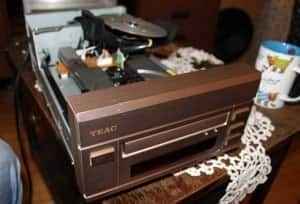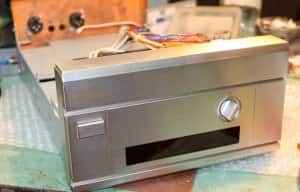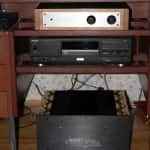Funny pair is in possession of HiFish – Buddy from Baby DiyA ;
Lately , transport (P-700 ) started making troubles with drawer mech , so attempt to repair that was perfecttly timed for major rework of his twin cousin , D-700 .
Some cleaning , lubricating and exchange of rubber parts in mech. was everything needed to make transport functional again.
so , few pics of transport :
Now – DAC box , D-700 ;
As both boxes were previously (in previous life ) victims of classical Hi End Wizards (read – make few tweaks collected from popular Hi End bag of tricks , take mucho greenies and run) , I was so disgusted , so didn’t even photographed how quasi balanced outputs were made , signal through generic 100uF Electrolytes , loose WBT RCAs etc.
Changing caps and OPs for something fancier never was my game , while game is End of The World named 😉 , so – after thorough reading of datasheet of DAC chip used here (AD1862N) I decided to simply sweep everything used in factory , as I/V conversion and output stage.
What I like to use , when DAC chip (declared with I output) is having properly high output impedance , is nothing else then small mic signal xformer , with voltage ratio of at least 10x .
As is case with this DAC box , when two AD1862N (SE output per chip ) are used in balanced/differential mode – per channel, benefit of using transformers is even bigger – we can connect it’s primary directly between pos and neg DAC chips , so their outputs are free of ground , at least in usual manner .
AFter sweeping all parts after DAC chips , I had enough room , free traces and holes for creative 😉 positioning of xformers and rest of small parts ;
put them , made usual Test CD frequency sweep, determined what’s proper loading on secondary side.
From factory – 6Vpp was on output ; with this solution , I have 2.5Vpp after xformers … plenty enough , so I decided to put just Toshiba Jfet buffers as final elements .
OK , enough of typing – rest you can see on pictures .
There also was needed to put proper IEC mains inlet , in place of 7-pin XLR , which already mentioned Hi End Guru put there from some dubious external PSU connecting reasons 😉 .
Sound …… well – priceless 😉





